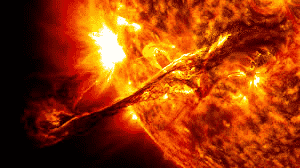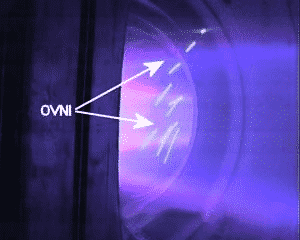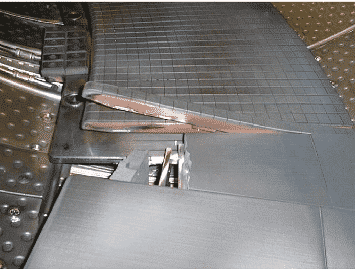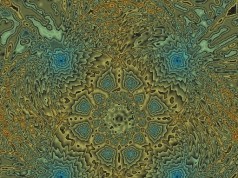There are only two fundamental, independent sources of energy: nuclear fission and nuclear fusion. All other energy “sources” are derivative of those two.
The distance between the world’s two most expensive science experiments, ITER and CERN, is less than 300 kilometers. Both powered by French nuclear energy. Discuss.
Fission nuclear energy powers the Earth (magnetic shield, plate tectonic, continental drift, subduction, volcanism).
Fusion nuclear energy powers the Sun (and thus the biosphere, past and future). (Thus those who hate “nuclear” should go see a shrink, and I’m here to help them before they hurt someone. )

The center of the Sun is submitted to enormous pressure (340 million times atmospheric pressure), and a temperature of ten million degrees Kelvins. That‘s too hot, that is, too violent for atoms: shocks tear electrons from nuclei, and make an electron gas mixed with a gas of nuclei, that’s called a plasma.
Nuclei, each equipped with a positively charged proton, repel each other electrically.
[Sol is actually brighter than 85% of stars in the Milky Way; it’s actually white; the atmosphere scatters the blue component of light, making it look yellow from Earth’s surface!]
600 million tons of the Sun’s hydrogen fuse, converting 5 million tons to energy, each second.
The enormous pressure and heat mean that hydrogen nuclei are packed up close together, and are extremely agitated, with gigantic kinetic energy. So, sometimes, two protons crash into each other head on, and the violence of the collision overwhelms the electric repulsion.
At very short range the nuclear force is attractive. It overwhelms all other forces, and the two protons stick together. This happens more readily if two electrically neutral neutrons join in, as they contribute their attractiveness, and none of the electric repulsion.
British physicists Aston and Eddington suggested in the 1920s that the sun got its power from fusing Hydrogen into Helium. Indeed adding the mass of two heavy hydrogen nuclei (each with one proton and one neutron) is more than that of the Helium nucleus they fuse into. The difference is released as energy, according to the famous Poincare’(-Einstein) E = mcc formula.
“Synthesis of the Elements in Stars“, published in 1957 by the extremely famous astrophysicists Margaret Burbidge, Geoffrey Burbidge, William Fowler and Fred Hoyle, demonstrated convincingly that most elements in the universe had been synthesized by nuclear reactions inside stars. Heavy elements, such as iron, had been produced by the dramatic explosions of supernova.
As I have argued in H Fusion Or Bust, we desperately need nuclear energy, as our main energy system, burning fossils, is both running out and poisoning the entire biosphere, killing already an unbelievably unnoticed several million people a year (soon to be dozens of millions a year, dead). Unfortunately, millions of retards are goose stepping behind well organized, and well paid fossil fuel propagandists, and doing nothing about it, while they howl about nuclear energy.
One angle of attack for reducing pollution is to build Thorium-U233 fission plants. Such reactors have lots of advantage, including the fact be made before and have unproblematic waste. (What’s less easy is to scale them up economically, because it was not done before; India and China have massive programs.)
Thermonuclear fusion has been mastered in bombs, using the dirty trick of using the fantastic temperature and pressure of an exploding Plutonium fission “pit”. That would allow to explode bombs as powerful as 100 Megaton of TNT, or more, enough to bust or deviate a large comet or asteroid.
Some adore the facile joke of saying thermonuclear fusion has been the energy of the future, and always will be. It’s idiotic: it took 7 centuries between the invention of gun powder in China and the first (hydrogen!) internal combustion engine, a succession of explosions (early 19C, Switzerland).
There are two main approaches for inducing fusion: shock, and heat (like in an H bomb), using lasers. This approach is pursued in the Bay Area and Bordeaux. It tends to be military financed, as it simulates H bombs, and lasers are irresistible to real men.
The other approach is the Tokamak (abbreviation of Russian for TOroidal Chamber MAKgnetic). France, as usual in the last three millennia, is at the forefront of the effort to create new technology. The French already built no less than four tokamaks, and their Tore Supra has enlightened us all with phenomena never seen before. It found OVNIs (Objet Volants Non Identifies)

[Tore Supra, Cadarache.]
France has few natural resources, but the will to produce a lot of ideas. She is adamant to make nuclear fusion work. As the New Yorker puts it:
“if all goes according to plan, the most complex machine ever built will be switched on in an Alpine forest in the South of France. The machine, called the International Thermonuclear Experimental Reactor, or ITER, will stand a hundred feet tall, and it will weigh twenty-three thousand tons-more than twice the weight of the Eiffel Tower. At its core, densely packed high-precision equipment will encase a cavernous vacuum chamber, in which a super-hot cloud of heavy hydrogen will rotate faster than the speed of sound, twisting like a strand of DNA as it circulates. The cloud will be scorched by electric current (a surge so forceful that it will make lightning seem like a tiny arc of static electricity), and bombarded by concentrated waves of radiation. Beams of uncharged particles-the energy in them so great it could vaporize a car in seconds-will pour into the chamber, adding tremendous heat. In this way, the circulating hydrogen will become ionized, and achieve temperatures exceeding two hundred million degrees Celsius-more than ten times as hot as the sun at its blazing core.”
ITER will the hottest phenomenon in the Solar System, ever.
Like the sun, the cloud will go nuclear. The zooming hydrogen atoms, in a state of extreme kinetic excitement, will slam into one another, fusing to form a new element-helium-and with each atomic coupling explosive energy will be released: intense heat, gamma rays, X rays, a torrential flux of fast-moving neutrons propelled in every direction. There isn’t a physical substance that could contain such a thing. Metals, plastics, ceramics, concrete, even pure diamond-all would be obliterated on contact, and so the machine will hold the superheated cloud in a “magnetic bottle,” using the largest system of superconducting magnets in the world. Just feet from the reactor’s core, the magnets will be cooled to two hundred and sixty-nine degrees below zero, nearly the temperature of deep space. Caught in the grip of their titanic forces, the artificial earthbound sun will be suspended, under tremendous pressure, in the pristine nothingness of ITER’s vacuum interior.
No one knows ITER’s true cost, which may be incalculable, but estimates have been rising steadily, and a conservative figure rests at twenty billion dollars-a sum that makes ITER the most expensive scientific instrument on Earth. But if it is truly possible to bottle up a star, and to do so economically, the technology could solve the world’s energy problems for the next thirty million years, and help save the planet from environmental catastrophe. Hydrogen, a primordial element, is the most abundant atom in the universe, a potential fuel that poses little risk of scarcity. Eventually, physicists hope, commercial reactors modelled on ITER will be built, too-generating terawatts of power with no carbon, virtually no pollution, and scant radioactive waste. The reactor would run on no more than seawater and lithium. It would never melt down. It would realize a yearning, as old as the story of Prometheus, to bring the light of the heavens to Earth, and bend it to humanity’s will. ITER, in Latin, means “the way.”.
The main road to the ITER construction site from Aix-en-Provence, where I had booked a room, is the A51 highway. The drive is about half an hour, winding north past farmland and the sun-glittered Durance River. Just about every form of energy is in evidence nearby, from hydroelectric dams to floating solar panels. Seams of lignite, a soft brownish coal, run beneath the soil in Provence, but the deposits have become too expensive to mine. Several miles from Aix, a large coal plant, with a chimney that climbs hundreds of feet into the sky, is being converted to burn biomass-leaves, branches, and agricultural debris.
Actually the chimney is 300 meters tall, and not just a symbol of pollution, but a real health problem when there is no mistral and a temperature inversion. When there is mistral, the pollution can head towards Rome. ITER is up the Durance valley. At its source, my daughter was born. Up the nearby Rhone valley, nuclear power reactor parks have the added touch of giant windmills on site while atomic powered Very High Speed trains zoom by (in case, somehow, power goes down, the mistral is supposed to help, as it already did, 1,000 years ago).
In 1997 the JET (Joint European Torus) based in England, produced about as much power through fusion as what put in. So controlled thermonuclear fusion is not a dream. The reactor instantaneously overheated, within a second, and had to be shut down.
Meanwhile in Cadarache, the French tokamakTore Supra succeeded to confine thermonuclear plasma for more than 6 minutes (by opposition to just one second in JET). Tore Supra could do this as the world’s only tokamak with supraconducting magnets to generate long term magnetic fields. Tore Supra’s walls were built of pure carbon, same as the nose of the space shuttle. It looked like a good guess: carbon has the highest solid temperature (it sublimates directly).
Plasmas are occasionally unstable: look at the picture of the Sun above, complete with explosions, and prominences hundreds of thousands of kilometers long. In a reactor, everything can be perfect for long minutes, and then suddenly all goes to hell without a hand-basket, and the plasma comes in contact with the walls, photo-abrading, tearing carbons away, and prying some of the strongest materials on Earth with forces of hundreds of tons, as if they were made of cardboard:

The forces that can be unleashed in a thermonuclear reactor are of the order of the largest rockets ever launched (and even several times that in ITER). The French nuclear safety authority forced the ITER organization to make the reactor’s floor twice stronger than it wanted it to be (the Princeton tokamak jumped in the air).
Not touching the walls is part of the Plasma Facing Material problem (PFM). The plasma, once loaded with tritium, then would have combined to create radioactive carbures. So the French scientists discovered that carbon, in appearance the best candidate for PFM had to be given up.
JET has been rebuilt as a forerunner of ITER, it is now relined with Beryllium . The results have been excellent, and ITER will go directly to such a lining. (Baby ITER, JET will be reloaded with radioactive, easy to fuse, Tritium within two years.)
French Physics Nobel, Pierre-Gilles de Gennes said of controlled nuclear fusion, “We say that we will put the sun into a box. The idea is pretty. The problem is, we don’t know how to make the box.”
The problem is obvious: the highest temperature a solid can sustain is less than 5000 Kelvins at room temperature. The plasma is 40,000 times hotter.
The box has to be electromagnetic. And it has to be perfect, and require mathematics beyond what we can master (mathematics break through allowed the long term containment in Tore Supra). Can it be done? It better be. There is no other option.
Except war. But Putin, the world’s most powerful dictator, already thought of that one.
Putin, of course, is a self-satisfied, vicious idiot with a short alpha man inferiority complex. This shows that the present dominant political system, electing “leaders” every now and then, is, itself, idiotic. The invasion of Ukraine could lead, indeed, to a world war, under some scenarios. Scenarios under which the “West” would act perfectly, let it be said in passing (in 1939, France and Britain, by declaring war to Hitler, acted perfectly. later the war went badly, but that’s another subject).
Idiocy is not just deplorable, it’s a moral problem. In the USA, one meets people raging against France all the time. That makes them morally inferior, and such people were gung ho for invading Iraq.
Basically, anything the USA can do, France can do. No exception. France is the only state capable of this, in the world (even Great Britain buy part of its strategic nuclear deterrent in the USA; France makes its own, and its arguably as limber as the USA’s).
This goes a long way to explain anti-French racism in the USA: here is a Socialist country that does just as well, does not that prove being a slave to Wall Street is pointless? France socialist? Not only the Parti Socialiste holds most elected offices, state spending in France is 57% of GDP (the highest in Europe with Denmark, but Denmark can’t make war around the world).
What the millions of little American minds who rage against France are truly raging again is anything that could hurt their master, plutocracy.
Another example of raging idiocy is directed at CERN. OK, CERN is an abbreviation from the French, and the Large Hadron Collider is mostly below France and fed by French nuclear power, so it’s related to the preceding.
Critics of CERN claim it could swallow the Earth, thus demonstrating their lack of education. Ironically, they probably read that on the Internet. And CERN invented the World Wide Web.

Would CERN haters become less hateful if they read on the Internet that CERN invented the WWW? Not sure. Idiocy is fungible. If it’s not this, it will be the other thing.
There is no solution to the mayhem caused by burning fossil fuels, except nuclear energy. No solution, except war. But Putin, the dictator of the world’s largest petrostate is already a pawn for that system of thought.
Patrice Ayme





